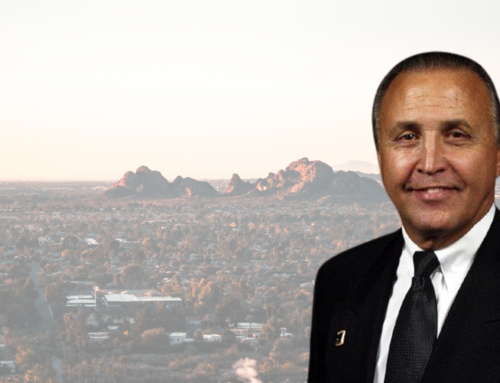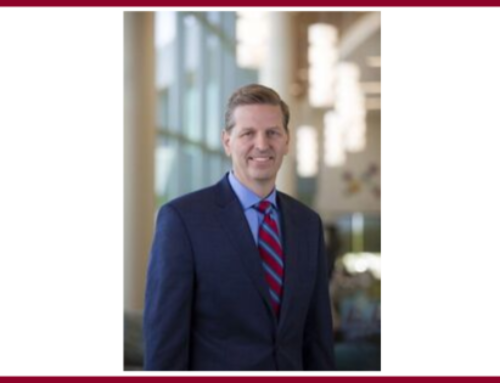Written by: Chris Bailey, MD
The Arizona Medical Association (ArMA) has the privilege of engaging with a surplus of interesting, dynamic, and involved physician members. One such member is Dr. Jennifer Hartmark-Hill, a Mayo Clinic-trained Family Medicine Physician, Alum of the University of Arizona (UA) College of Medicine, and medical educator. She currently wears many hats, serving as the Director of the UA Faculty Development Fellowship, Director of the Program for Narrative Medicine & Health Humanities, and Director of the Patient-Centered Care curriculum.
Among countless other accolades, Dr. Hartmark-Hill is a Gold Humanism Award recipient for her care for vulnerable populations, including outreach to patients experiencing homelessness through Street Medicine Phoenix. She has a long-standing track record of service and leadership across organizations in Arizona including ArMA. Currently, Dr. Hartmark-Hill is ArMA’s President-Elect and chairs the Public Health Committee
As the Chair of ArMA’s Communications Committee, I had the honor of conversing with Dr. Hartmark-Hill on several topics including medical advocacy, the evolution of medical education, and the importance of organized medicine. I kicked off the interview by asking how she became the medical educator, physician, and advocate she is today.
1) Can you provide some background on what drove you to become a physician?
My story starts in a very small town in rural Minnesota up by the boundary waters area (and about an hour south of the Canadian border). The region was significantly medically underserved. I saw the impact of this first-hand on many families, including my own, when my baby brother contracted bacterial meningitis in the early 80s, an illness that is now nearly eradicated thanks to vaccinations.
I’ve been passionate about advocating for underserved areas and populations throughout my career. I’ve worked at several Federally Qualified Health Centers over the years and have found the work incredibly rewarding. I currently engage in inpatient care with Street Medicine Phoenix, a student and faculty volunteer organization from the UA College of Medicine-Phoenix, which provides free care for people experiencing homelessness. I’m also involved in providing faculty development to Clinicians in rural areas who are training our next generation of health professionals to expand access to care there. It’s immensely satisfying to contribute in these ways, and to be informed by my early experiences, and to give back in the ways that I can. It’s been quite an adventure over the years!
2) As a medical educator, you have a unique perspective on how education changes and evolves. How do you see medical education changing and evolving as technology becomes more involved in our daily lives?
I think that as technology evolves to be able to simulate more and more procedural and patient care scenarios, as well as interactive virtual classroom sessions, we have a responsibility to ensure that we are thoughtful and intentional to use it as a tool to promote what matters: meaningful connections between teams of learners, therapeutic relationships, and goal-setting for continuous quality improvement and educational interactions that empower.
Two things that stand out in my mind the most from the myriad virtual events and conversations over the past year and a half are these:
- How much people wished they could connect in person, which makes sense because 90% of communication is non-verbal.
- The desire expressed by members of often marginalized populations, such as those living with disabilities, that some form of remote connection continues when we emerge into the post-pandemic era. For all of the downsides of remote meetings and online events, the increased access and connection for many folks on these platforms is something that I am dedicated to remembering and advocating for going forward.
3) You have been very involved in organized medicine throughout your career. How did you initially get involved?
I am forever grateful to the Arizona Academy of Family Physicians (AZAFP) and MICA for co-sponsoring an “Emerging Leaders” two-day training program, which I was fortunate to participate in when I was a co-Chief Resident at Mayo Clinic Arizona. I emerged from that training with a much clearer vision for how I could engage with policymakers to make a positive difference. The training opened my eyes to how important advocacy is to patient care and the future of the profession. Thereafter I became involved in AzAFP’s Legislative Task Force and then ArMA’s Legislative & Governmental Affairs Task Force, thanks in large part to Dr. Jacque Chadwick, one of ArMA’s past presidents, who chaired the committee at that time.
4) I’ve heard you advocate for medical students to become involved in organized medicine. What advice would you give them for getting involved?
There are two main ways I’d recommend. First, reach out to the Medical Students Section of ArMA to connect with a group of highly motivated medical student leaders who can show you the ropes. The second way (and I recommend both), is to reach out to a faculty member or physician leader in the community who is involved in organized medicine and advocacy. Often, this can be a physician in a specialty or subspecialty in which you have future career interest, but it doesn’t have to be. Their perspectives and connections will give you opportunities, and their mentorship will nicely complement your student connections. Don’t worry about identifying your top areas of advocacy interest ahead of time. A mentor who knows how to ask more coaching-type questions can help you define your strengths and interests.
5) As you mentioned earlier, medical education is constantly evolving. As an educator, how do you continue to learn to stay on top of the changes?
I’m constantly learning so that I can better teach! I absolutely love being a medical educator, and I teach in all four years of our curriculum. This includes directing courses and electives, teaching in the clerkship setting, and helping colleagues facilitate reflective discussion and writing sessions. I also direct the UA Faculty Development Fellowship, which is a two-semester 9-month intensive training for faculty to improve their teaching, scholarship, and leadership. I have the privilege of collaborating with many content experts across sessions we develop, and the more I learn, the better the value of the sessions for learners. So, it’s a win-win and a lot of fun! As far as resources, I do read a lot of journal articles across a variety of fields in medicine and education, and I’m also a big fan of podcasts like the “Faculty Factory” podcast out of Johns Hopkins, “KeyLIME Podcast” which has an international literature review focus, and of course, the clinically-oriented AFP podcast, produced by our very own UA College of Medicine-Phoenix Family Medicine Residency, which is one of the top podcasts in Medicine year after year!
6) The COVID-19 pandemic greatly disrupted healthcare around the globe, and we’ve seen changes in the way that care is delivered as a result. How do you anticipate the effects of COVID-19 to change the delivery of medical education moving forward?
I think one of the biggest changes that medical educators and learners lived through was the transition of nearly all curriculum to remote and virtual environments throughout the pandemic. This was really tough for our medical students who wanted to take part in helping patients and clinical teams. It also impacted patients directly in terms of fewer outreach services to vulnerable populations, in which our medical students play a major role. A silver lining to all of this was that quite a bit of exciting innovation was created in the curriculum-delivery space by dedicated faculty, which spring-boarded active learning approaches years in advance.
Going forward, one thing I am passionate about is building telemedicine infrastructure with supported remote and mobile connections. This will ensure that patients with resource limitations and those experiencing homelessness will not have the severe reduction in access to services that they did during the pandemic. I strongly believe that anytime we build infrastructure and community networks that best serve our patients, these are also some of the best environments in which to train our future healthcare professionals. That way, there is no disconnect between learner’s knowledge and skills, and what best serves our patients and communities.
7) As you well know, students all over the state are preparing to enter residency. What is one word of advice you would give to them?
Spend time revisiting and reflecting on why you went into Medicine. Write a representative phrase or two down and put it somewhere you can look at it every day. Add words of affirmation and encouragement for yourself and words of self-compassion for when times get tough. It will be this value-based leadership approach that will get you through each stage of your training (and your future career) in ways that are meaning-making and purpose-based. Reach out to those in your support system, and ask for their help. Ask for them to check in with you from time to time and hold you accountable to your values and your practice of self-care and self-compassion. Finally, look for ways to show the people around you, in your work environment and personal life, small acts of gratitude on a daily basis. Gratitude will keep you grounded!
About the Author

Christopher Bailey, MD, D.ABA is an ACGME fellowship-trained specialist in Interventional Pain Medicine, and is a board-certified physician in Anesthesiology and Pain Medicine by the American Board of Anesthesiology. He specializes in spinal cord and peripheral nerve neuromodulation, regenerative therapeutics, and novel interventional approaches to chronic pain. Dr. Bailey has been recognized as an “Emerging Leader” by the American Society of Anesthesiologists, and is honored to serve as a Board Member and the Communications Chairperson of the Arizona Medical Association. He is a former Graphic Designer and Branding Consultant, who previously served as Phoenix Chapter President and national executive board member for Division V of the American Advertising Federation. Dr. Bailey attended The University of Arizona for his undergraduate studies and is a graduate of the Mayo Clinic School of Medicine. He trained in Anesthesiology and Pain Medicine at Mayo Clinic, where he served as Chief Resident, and had the academic rank of Assistant Professor prior to joining the Pain Institute of Southern Arizona as an Interventional Pain Specialist.





